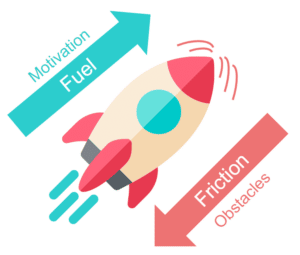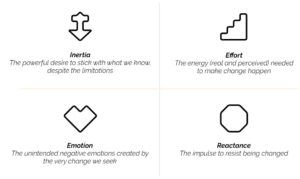There are two paths to achieving the growth goal — adding fuel and reducing friction.
TL: DR
- We all want to keep growing in life. Growth feels good. The goal of business is creating ‘more’ which involves “growth.”
- There are two paths to achieving the growth goal — adding fuel and reducing friction. In business, most recommendations and actions focus on “adding fuel.”
- However, in most situations, there is also a lot of friction, both seen and unseen. Friction slows us down from reaching our goals. While some friction is good and necessary, there is often more than the ideal amount.
- We are implementing strategies to reduce friction in our personal / home lives. It takes the form of “subtraction,” “decluttering” and “minimization.”
- Removing obstacles, or reducing friction, is an underutilized tool in business. Incentives in the workplace (how we are evaluated, recognized, and rewarded) are less suited to noticing and valuing the removal of friction.
- I share two questions you can ask to begin the process of uncovering potential frictions.
- And offers some thoughts on activities that can reduce friction in employee and customer interactions.

Paying homage to my cultural upbringing, I am leading with an image of Ganesha.
The elephant-headed God of the Indian pantheon is known as “the remover of obstacles.”
Visitors to Indian homes will likely see at least one image of him. When you take taxis, buses or “rikshaws” in India you will be sure to see an image of Ganesha at the front, to offer good luck to the driver in navigating the traffic.
I have an image of Ganesha sitting in front of my monitor as I write this article.
I have learned the hard way that effective writing is a lot about subtraction. I start with a bevy of thoughts, whittle them down, remove unnecessary words, and consider if the output is valuable to a reader. In that sense, this topic is particularly relevant to me as a writer.
Growth is ‘Good’
“Growth is good. Through history, economic growth in particular has alleviated human misery, improved human happiness and opportunity, and lengthened human lives.” — Tyler Cowen, Stubborn Attachments.
If “business” and particularly “start-ups” were to be summarized with one word, that word would be “growth.” See Paul Graham’s iconic blog post on ‘growth’ here.
Growth is the process of creating “more.” And in business, the capital markets (investors and lenders) value growth — more customers, more revenue, more cash flow, etc.
When we contemplate creating “more,” the first thought typically is ‘what thing(s) should we add or do.’
It is much less common to think about items we should remove or activities we should stop doing.
Fuel and Friction
Fuel: Anything that increases the likelihood the desired outcome is achieved. It is something additive. Often delivered to consumers and employees in the form of incentives or rewards. The most common metaphor for fuel is it helps us get to a destination.

Friction: Anything that reduces the likelihood of achieving the desired outcome. It can be visible or unseen (to some of the parties involved, even if others know it exists.) Friction has a negative connotation. Although life, as we know it, would not exist without friction.
Fuel in Business
No one would argue against growth. Growth is equated with progress; progress that we all want to make.
The instinctual reaction in pursuing growth is to brainstorm actions we ought to take to achieve the goals we have set for ourselves or that our bosses have set for us.
Most of our time is spent making our offer (whether we are selling ourselves, our company, or our product) more attractive to the ‘buyer’ by adding things. These actions are referred to as “adding fuel.”
In marketing and sales, adding fuel looks like: discounts, two-for-one offers, free shipping, money back guarantees, more persistent advertising, increasing the number of leads, etc.
In product development, adding fuel looks like: adding new features, decreasing site load times, reducing clicks to pay etc.
In hiring and retaining employees, adding fuel looks like: offering signing bonuses, giving (larger) raises, incremental/refresh option grants, new titles etc.
I believe we spend more time on fuel for a few different reasons.
- Additive action feels useful. Humans want to feel useful.
- Additive actions are easier to see in real-life and to visualize for bosses and investors in charts and graphs.
- Our reward system (incentive compensation) most commonly measures actions taken.
- Bigger numbers (we raised $100 million vs. we raised $10 million, or I managed a team of 100 vs. 10) are more impressive especially to recruiters and prospective employers. Even though running the company on less cash with fewer employees might be the more value creating decision.
Transforming Our Personal Lives
Many of us are incorporating the “less is more” mantra into our personal lives. Marie Kondo debuted on Netflix in January 2019 advising us to “Discard everything that does not spark joy” and her approach captured the minds and hearts of millions of viewers.
Simplicity, decluttering, down-sizing, minimalism, experiences over goods, and sharing underused assets (homes, cars, boats etc.) have gained in importance in part due to greater self-awareness of the impact of “excess consumption” on the health of the planet.
A lot of the recent thought on enabling good (and new) habits to stick has focused on friction reduction. Example include modifying our environment (e.g., removing temptations such as sugary, high calorie foods, or turning all notifications off on our phone during work hours etc..) and cueing future good behavior (e.g., leaving our exercise clothes and shoes out in plain view before bed.) James Clear’s book Atomic Habits focuses on how small changes like these can lead to big positive outcomes. I am a big fan of his writing.
On a much less grand scale, we often simplify in making new recipes (some might call it short cuts). We leave out certain ingredients (because we don’t have them) or cut out some processes (i.e., don’t make the extra sauce to accompany the dish or the icing for the cake.) While this approach doesn’t always work, it does quite often. Leidy Klotz, a professor at University of Virginia, has written extensively on the topic of how we can unleash the power of “subtraction” to create better outcomes.
Change is Hard
Some reasons to explain why change is hard include:
Inertia. As humans we are programmed to continue doing what we have been doing (law #1 of the three laws of human behavior.) In other words, we naturally resist change, even changes we know are good for us.
Achieving many of our “meaningful” professional objectives requires other parties to make a change from their status quo. “Meaningful” professional objectives include hiring a new team member, getting a new job, convincing your boss that you deserve a promotion in title or a raise in pay, winning a new client, convincing the client to buy more etc.
Prospect Theory. When faced with uncertainty about the future, potential losses are valued more highly than offsetting potential gains. Every decision to make a change involves us weighing potential losses and gains. Daniel Kahneman won his Nobel Prize for this work.
The Endowment Effect. This refers to how we place a higher value on something we have compared to the value we would place on the same thing if it were simply available for sale. In other words, ‘the devil we know is better than the devil we don’t.’
Gains are Public (Employer gets them disproportionately) while Losses are Private (Employee feels them disproportionately). If a change results in a positive benefit (more revenue or reduced costs), most employees don’t directly benefit. However, if a change leads to a loss (bad outcome for the business in the form of the new solution not working as well or at all), then the blame will accrue more heavily to the person who made the decision.
Adding fuel is often not enough to overcome these challenges. Hence the recommendation to address friction points.
Brainstorming Ways to Reduce Friction
Reducing friction requires understanding the perspective of the buyer or user of a product or service.
Every buyer or user considering a new product, new service or new company/job is asking themselves, “Do I want to go through the hassle to do this (try something new which could take more time, cuts off other choices, and might not deliver on its promises)?”
My recommendation: focus on both emotions and logic. Every choice to make a change has a component of logic (what benefits will I get?) and emotions (how do I hope to feel after I make this change?)
Utilize these two heuristics to brainstorm ways to reduce friction.
- Have Empathy for the Buyer. Ask the question: “If I were that person, what would concern me?”
- Reduce Information Asymmetry. Ask the question: “If I were that person, what else would I want to know?”
Loran Nordgran and David Schonthal, both professors at the Kellogg School of Management, have written a book about overcoming resistance to new ideas by reducing friction called, The Human Element. They explore the different types of friction in detail (image below) and their topic makes a great Hidden Brain podcast.

Some Ways to Reduce Friction
In Communication
- Make it easier for the intended target to consume / understand your content. Some examples of friction reductions strategies include:
- Providing summaries at the top
- Highlight the important points in a longer-form article.
- Provide on-demand playback (for asynchronous consumption).
- Enable faster listening speeds for audio presentations (1.5x / 2x).
- Have high fidelity, low effort ways for prospects and clients to connect with you
With Prospective Hires
- Build trust during the process. Disclose less attractive aspects of the job and challenges the company is working to overcome before making offers.
- Help people imagine their future. Showcase career paths, especially for less senior roles.
With Employees
- Set defaults that favor the behavior you want (i.e., minimum contribution level of a 401(K) plan), while allowing for changes.
- In feedback (1:1 or group retros), ask for things that the company, the team or you (the manager) can “stop doing.” While the “START, STOP, CONTINUE” feedback framework is commonly used, it is rare to get feedback on things to stop.
- Make the environment safer for employees (especially direct reports and team members) to share uncomfortable feedback and feelings.
With Prospective Customers
- Invest the time to compare in detail the current process/workflow (including all parties and time involved) and compare it to the new normal with your offering.
- Disclose more upfront without being asked (particularly price transparency.)
- Proactively address common objections, rather than spending all your energy selling the strengths of your product.
- Reduce the steps they need to take to get a firm offer from you (in enterprise sales). Every additional step or action creates an opportunity for a prospect to reconsider.
With Customers
- Offer onboarding services and particularly handholding in transitioning from the old product / service to your new offering.
- Make cancellations easier.
- Reduce the hassle in product returns.
- Manage expectations — what they will get from you and when.
Change is a Personal Choice.
Each person must make their own choices on change — what change(s) to make, when to begin, how much to undertake and whether to stick with them.
I have learned from personal experience that neither all the logic in the world nor the promise of future positive emotions can force me to change. I have to actively and intentionally embrace change.
While change is hard, I do know spending time on removing and reducing frictions will drive a better future for all of us.
We can create better environments in our workplaces, increase customer satisfaction and loyalty, and have greater success with our prospects (new hires and new customers) if we spend the extra time to understand and reduce friction points.
Join our community for more tips on leadership and business acumen. Learn more.
